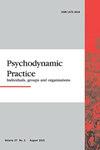心理动力学心理治疗师在线存在-概念考虑和调查研究
IF 0.4
Q4 PSYCHOLOGY, CLINICAL
引用次数: 1
摘要
数字技术显著增加了心理动力心理治疗师(pdp)在互联网上的存在,从而从根本上改变了心理动力治疗的框架。关于pdp如何塑造他们的在线存在与他们的心理动力学匿名性以及自我表达的可能性之间的关系,缺乏数据。使用互联网进行交流和自我表达越来越多地被年轻一代融入日常生活,这也适用于年轻的培训pdp和年轻的患者。在第51届IPA大会期间(2019年7月24日至27日),我们对50名pdp进行了一项探索性的纸笔调查,使用了一份关于他们自己在线表现的自编问卷。很大一部分受访者(男:88%,女:70%)表示,他们的心理动力工作对他们在网上实际透露的自我形象有影响。尽管如此,大约一半的受访者表示,他们通过照片(50%)、facebook等社交媒体(54%)或科学文章(54%)出现在网上。50岁以下的人与老年人的不同之处在于,年轻人使用数字媒体的频率越来越高。50岁以上的受访者比50岁以下的受访者更有可能认为在网上分享太多信息的人是“糟糕的pdp”。这些数据表明,pdp的理想表现与实际表现之间存在差异。在我们看来,pdp决定在网上分享他们自己的信息不是基于道德辩论,也不应该这样做,特别是在与年轻pdp的培训协会中。它是关于如何在心理动力学过程中分享和处理这些信息。这些主题应该被强制地固定在心理动力学训练中。本文章由计算机程序翻译,如有差异,请以英文原文为准。
Psychodynamic psychotherapists online presence- conceptual considerations & survey study
Digital technologies have significantly increased the internet presence of psychodynamic psychotherapists (pdp) and thus fundamentally changed the framework of psychodynamic treatments. There is a lack of data on how pdp shape their online presence in relation to their psychodynamic anonymity as well as the possibility of self-expression. The use of the internet for communication and self-expression is increasingly being integrated into everyday life by the younger generation, which also applies to young pdp in training and young patients. During the 51st IPA Congress (July 24–27, 2019), an explorative paper-pencil survey was conducted on 50 pdp using a self-constructed questionnaire regarding their own online presence. A large proportion of those questioned (m: 88%, f: 70%) stated that their psychodynamic work had an impact on what they actually revealed about themselves online. Nonetheless, about half of the test persons stated that they were present online through photos (50%), social media such as facebook (54%) or scientific articles (54%). People who are younger than 50 years old differ from older people in that younger people use digital media significantly more and more frequently. Respondents over the age of 50 are significantly more likely to assume that pdp who share too much information online are ‘bad pdp’ than those under 50. These data suggest a discrepancy between the pdp‘s ideal and the pdp’s actual behaviour. In our opinion, the pdp’s decision to share information about themselves online is not based on an ethical debate and should not be conducted as such, especially in training associations with young pdp. It is about how this information is shared and treated in the psychodynamic process. These themes should be compulsorily anchored in psychodynamic training.
求助全文
通过发布文献求助,成功后即可免费获取论文全文。
去求助
来源期刊

Psychodynamic Practice
PSYCHOLOGY, PSYCHOANALYSIS-
CiteScore
0.90
自引率
0.00%
发文量
41
期刊介绍:
Psychodynamic Practice is a journal of counselling, psychotherapy and consultancy and it is written for professionals in all fields who use psychodynamic thinking in their work. The journal explores the relevance of psychodynamic ideas to different occupational settings. It emphasizes setting and application as well as theory and technique and focuses on four broad areas: •Clinical practice •The understanding of group and organisational processes •The use of psychodynamic ideas and methods in different occupational settings (for example, education and training, health care, social work, pastoral care, management and consultancy) •The understanding of social, political and cultural issues
 求助内容:
求助内容: 应助结果提醒方式:
应助结果提醒方式:


